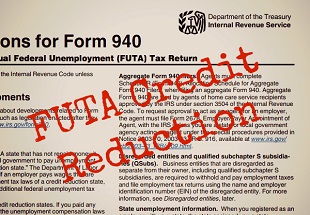 According to the federal Labor Department’s Office of Unemployment Insurance, the reductions in the credit that employers can apply to their federal unemployment tax rate will be in effect for 2015 again for employers in those states that are still working to repay their loans from the federal unemployment account. These continued FUTA credit reductions will impact payroll management for California employers.
According to the federal Labor Department’s Office of Unemployment Insurance, the reductions in the credit that employers can apply to their federal unemployment tax rate will be in effect for 2015 again for employers in those states that are still working to repay their loans from the federal unemployment account. These continued FUTA credit reductions will impact payroll management for California employers.
The State of FUTA Credit Reductions
States with a loan balance from the federal unemployment account on January 1, for multiple consecutive years, will experience a Federal Unemployment Tax Act (FUTA) credit reduction for the current year unless the state fulfilled requirements for relief from the reduction. Credit reductions have been in effect for some employers each year since 2009.
It is unlikely that employers in New York, North Carolina and South Carolina will have a FUTA credit reduction for 2015 because New York and North Carolina fully repaid their federal unemployment loans in May and South Carolina fully repaid its federal unemployment loan in June, causing these states to be free from credit reductions for 2015 unless the states need to again borrow from the federal unemployment account and have a loan balance Nov. 10.
It also is unlikely that Kentucky employers will have a FUTA credit reduction for 2015 because its current federal unemployment loan balance as of June 16 is merely $16.8 million, a far easier amount to repay than California’s $5.52 billion.
Projected Credit Reduction Percentages for 2015

HR and payroll professionals understand that there is a mandatory FUTA rate of 0.6% on the first $7,000 of wages an employee earns each year. This is calculated on a 5.4% credit applied to an actual FUTA rate of 6% that is granted for timely payment of FUTA. Consequently, the FUTA rate almost every employer pays is 0.6%.
However, largely due to the fallout of the economic downturn from 2008 on, several states have borrowed funds from federal loan accounts in order to fund their state unemployment payments. California was one of these states. Because many of these states, including California, have yet to repay these loans, they have been penalized with a reduction in the 5.4% credit to their FUTA rate. This is a cost that is borne by the private employers of each state, not the state governments.
The credit reduction to FUTA is normally applied in 0.3% increments that are indexed annually. This is payable each January when Form 940 is filed until the state’s loan is repaid.
Going into the end of 2015, a number of states have loans that will have been outstanding for five or more years. In addition to a further reduction of the FUTA credit rate, these states may be subject to an increase in their actual FUTA rates for 2015, with a tax called the Benefit Cost Rate Add-on Tax (BCR). The BCR will probably be higher than the 0.3% increment in the past.
Current FUTA Credit Reduction states expected to be affected by this BCR include California, Connecticut, Indiana, Kentucky, Ohio, and the Virgin Islands. Employers in these states also could be subject to a benefit-cost rate (BCR) add-on, which is an additional type of credit reduction that can apply for states that have possessed a loan balance on Jan. 1 of at least five consecutive years and which can vary among states because it is calculated based on states’ efforts to achieve solvency for their unemployment trust fund.
UI Loan Debt and the Prospects for California
The California Employment Development Department (EDD) recently published the October 2015 Unemployment Insurance (UI) Fund Forecast. For 2015, employers’ UI tax rates are based on the “F” contribution rate schedule, which is the highest rate schedule, plus a 15% surcharge. The surcharge is required by statute when the UI Fund reserve ratio is below a specified level.
The EDD fund forecast is based on the probability that employers will continue on this schedule through 2017, and beyond, if changes are not made to the financing structure.
California employers have had federal unemployment tax credit reductions since 2012, because of the deficit balance in the UI Trust Fund, As a result, the FUTA tax rate on California payroll has increased by 0.30% each year and is projected to increase from 1.80% for 2014 to 2.10% for 2015, 2.40% for 2016, and 2.70% for 2017.
So, how close is the state of California to paying off its federal UI fund loan deficit?
The California UI Trust Fund ended 2014 with a deficit of $8.6 billion. The Fund is projected to have a deficit of $6.7 billion at the end of 2015, $4.5 billion at the end of 2016, and $2.0 billion at the end of 2017. According to the EDD report “the current financing structure leaves the UI Fund unable to self-correct and achieve a positive fund balance sufficient to withstand an economic downturn.”
So, as things stand today, the UI Trust Fund will only increase in deficit for the foreseeable future.
In Addition to the FUTA Credit Increase There Is the Possibility of a Benefit Cost Rate Add-on Tax (BCR)
For 2015, California is slated to have a BCR add-on of 1.4 percent. In addition, California’s FUTA rate is expected to go from 1.8% to 2.1% under the regular 0.3% increase, but with an added BCR tax, it would probably go from the current 1.8% to 3.5%.
If the projected BCR add-on is applied for 2015, this would cause employers in California to be required to pay additional federal unemployment tax costs of up to $98 for each employee.
The US Dept. of Labor does not officially designate a state as a “FUTA Credit Reduction state” until late November of each year as the states have until then to pay off any existing unemployment loans. Based on the states which were subject to the credit reduction for tax year 2014, the states that will likely be subject to the FUTA Credit Reduction for 2015 will be California, Connecticut, Indiana, Kentucky, New York, North Carolina, Ohio, South Carolina, and the Virgin Islands.
It is expected that the following credit reductions will apply to the following states:
- California 1.5%
- Connecticut 2.0%
- Indiana 1.8%
- Kentucky 1.5%
- New York 1.5%
- North Carolina 1.5%
- Ohio 1.5%
- South Carolina (possibly 0% due to loan repayment)
- The US Virgin Islands 1.5%
It also appears that Arizona will become a FUTA Credit Reduction state in 2016 and Rhode Island will become one in 2017. These rates are, at best, estimates for now since the states can reduce the credit reduction or potentially avoid it all together as South Carolina succeeded in doing.
Staying on Top of FUTA and Payroll Management
For payroll managers, keeping up to date with continually changing Federal and State regulations and new legislation is a never-ending task. While some things, such as FUTA credit reductions, may be beyond your control, the consequences of mis-filing taxes, missing payments, or other withholding and tax filing errors can be costly for a business.
However, there are options to doing everything yourself.
If Accuchex is not currently filing your taxes, call to find out how we can smooth this process (and others) for your business. Let Accuchex help you in managing your HR needs, payroll processes, and staying on top of compliance demands. Get your Free Download: Payroll Outsourcing Guide to help you make an informed decision or call Accuchex Payroll Management Services at 877-422-2824.
In addition, get your copy of our free white paper: FUTA Tax Increases Why You Need to Plan Right Now!



